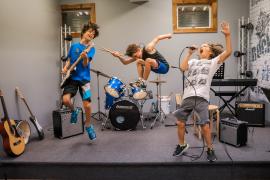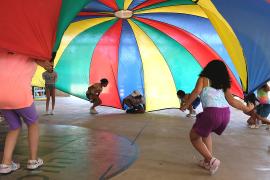Bon Jovi once astutely proclaimed, “Whoa, we’re halfway there!”
Now some may say that the band was writing about Tommy’s love for Gina, but I beg to differ. To my way of thinking, they were writing about the state of diversity in camp. We’ve made some amazing progress with regard to diversity in our camp populations — race, socioeconomic status, gender identity, nationality, physical ability, mental ability, and more. And while this progress is wonderful, it does not live up to the truest potential of coexistence. That’s right, my friends, the glass is indeed half empty, and if you believe that to be enough, you are “Livin’ On A Prayer.”
When I was five years old, I was diagnosed with Charcot-Marie-Tooth (CMT) disease, the same neuromuscular disease that my mother has. The name is a mouthful, but for me the experience has been a foundational source of humility, challenge, wisdom, and understanding. I have been in full “Forrest Gump”-style leg braces since I was 23. I run slower than most, I fall down a good bit, and I am forced to factor this disability into every decision I make. By nature of living my life and my formative years with a physical difference, I have been involuntarily put into a category. You can tell by watching me walk that something is not typical about my legs. Or you may draw the conclusion that I am drunk in public. I also remember the early years in my dad’s summer camp when I was still mostly “normal” and tried with all my might to maintain that appearance. I didn’t want other kids to know about my disability, much less focus on it. I was hearing Bon Jovi in my head again: “We’ve gotta hold on to what we’ve got.” And so it went through most of my youth; I did all I could to hold on to my ruse. That is, until Jason Conn and Brandt Lewis came along.
Jason Conn was my best friend in my pivotal early teen years. He was a true partner in crime, working side by side with me to obsess over girls and make our six weeks of camp the best of the year. With my dad as the camp director, and my ego in prime early-teen mode, I never talked about my disability — until one day when Jason and I were sitting in a field waiting for Gaga to start. Out of nowhere, Jason looked at me and asked, “So what’s up with your legs?” He knew something was going on but wasn’t sure what it was.
Without overthinking the moment, I told him that I had a disability that was affecting my hands and legs and that it would probably get worse as I got older. As I talked, I noticed that Jason wasn’t saying anything, so I turned around and saw that he had tears in his eyes. He was crying for me. As a result of being open and honest, I got the finest dose of true connection that two 14-year-old boys could muster. It was my first lesson that it isn’t enough to sit beside someone’s difference; that difference needs to be truly known.
My second dose came four years later. I was now a counselor at the same camp. And so was Brandt Lewis. Brandt was a good-looking guy — and he knew it. He was as cocky as could be, and most folks defined him as president of the Brandt Lewis fan club and not much else.
Every night at our camp, a fourth of the staff was “on duty,” making sure the campers were OK and actually sleeping. That meant the rest of the staff were free to head into the small town in eastern Maryland to socialize and grab a drink.
The walk from the cabins to the camp parking lot was up a long hill and across a small field. The bar-bound crew would meet and walk up the hill together. The small field at the top of the hill — filled with potholes and mini-craters and overgrown with tall grass — was the worst for me. You couldn’t see where the holes in the ground were. I would watch as the other counselors walked across it and laughed as if they had no idea they had entered the mine field of doom. I was always so nervous as I started across the field, because I knew I was likely to stumble, and I still wasn’t comfortable acknowledging my weakness — even though everyone already knew about my disability.
Yet, one staff member always found his way just in front of me as I entered the field. Brandt Lewis. He never said a word to me. He just positioned himself in front of me and kept walking with his hand held out behind him. This guy, who everyone was convinced was the biggest jerk on the staff, never passed up the chance to be my stability when I needed it most. His silent gesture sang out in perfect pitch, “Take my hand; we’ll make it, I swear.”
The Trinity of Inclusive Camp Success
Attitude sets the table for the dinner of dreams. To come into the summer and begin a program open to and wanting difference, leadership can very easily model a constructive camp culture.
Seek the Positives in Difference
I always look upon a camper or staff application with a positive and keen eye for any differences — physical, mental, cultural, racial, identity, and so on. And when I see an opportunity, I set my mind on how that difference can be a positive, both for the camper and for our camp culture. As a leader, to look a child in the eye and say, “I see you, and who you are is welcome here,” can mean the world.
I am the camp director for a group of youth who all deal with CMT, the disability I have. These kids are used to being seen as “disabled” or “different.” And yet, when they come into Camp Footprint, they are surrounded by other youth and many staff who also have CMT. This allows them to relax into who they truly are — to stop trying to hide or cover up and to just be open. The ease and joy that follows creates a space for youth to remember their true selves and to practice being that for a week. The goal is to send them back to their lives outside camp with truth as their norm.
This same scenario can be created for all youth and in all camps. And it must start with leadership — in the words you speak, in the manner that you connect with each staff member and camper, and in the moments you choose to highlight.
Teach Openness and Authenticity
As leaders, we need to show the campers how it is done. We need to model the method for our programs. For example, during staff training, I take off my shoes, leg braces, and socks, and I walk around in front of the group. This simple gesture makes it clear to the staff that they are a part of a program where truth and respect are key. Anytime during camp when I happen to stumble or need help buttoning a shirt or completing some other task, I always make it a very public deal. I want others to see that I struggle and need help — and, most importantly, that I am happy to ask for support. To include others in my disability. I look with a very careful eye during camp for any moments that organically show themselves to encourage a youth to share any part of their struggle tied to their difference. Without fail, once a youth opens up in front of their peers, the reception they receive tends to be positive — especially if it is backed up by a staff member in the right way.
When a kid asks me about my disability, I will look to include others in my answer. “Yes, my CMT challenges me every day. Tomas, I can imagine the same is true for you with your hearing loss.”
Or I’ll say, “I like to tell others about my challenges so they understand me better. Shelbi, do you talk to others about life in a wheelchair?”
It’s about teaching youth to talk openly about their truth in the same way they would talk about the color of their hair — simply and honestly — and helping youth to see that if their truth is not received with respect, that’s the receiver’s issue, not theirs. We must use the experience of camp to teach our youth how to be with one another — especially in the areas that our nation’s broader culture is getting it wrong.
Offer Encouragement
Lastly, when golden moments arise, we need to genuinely accentuate and celebrate them. When one of our campers shows respect for others, we grab the nearest radio and announce it to the camp. “Hey, Camp Footprint, I just saw Brody show amazing friendship and respect to his cabinmate!” At which point a bevy of responses come over the air: “Great job, Brody!” “Keep it up, Brody!” “That’s amazing, Dude!”
We choose to celebrate these golden moments by encouraging them. Over time, such behavior catches on as the camp’s culture.
If there are moments of disrespect (and there always are), it is equally important to address them head on. In a calm and supportive way, we remind the camper that, “This isn’t how we do things here at camp,” and then teach them why.
With Bon Jovi’s words in my head, “You live for the fight when that’s all that you’ve got,” I am encouraged to continue to inspire change in our camp programs. To actually practice what we know to be ideal. And to make Jason Conn and Brandt Lewis proud.
In general society, we don’t typically address our differences. It is considered polite to leave others to themselves, especially when it comes to such things. As a result, we are missing the opportunity to learn from one another, to understand one another better, and to absorb the lessons that we all have hidden in our challenges.
I have always believed we should talk about our differences. We should celebrate them as the very impetus for our greatness. And if general society is unable to accomplish this task, then we ought to be brave enough to create the culture in our camp programs — being the very change we wish to see in the world, one camp session at a time.
Photo courtesy of Camp Spearhead, Marietta, SC.
Jonah Berger, MS Ed, is the national youth programs manager for the Charcot-Marie-Tooth Association (CMTA) and director of CMTA Camp Footprint, serving youth with CMT. He is the author of He Walks Like a Cowboy and The Strangest of Places and a national motivational speaker, father, husband, drummer, and community creator. Jonah grew up in camp and also met his wife at camp.




